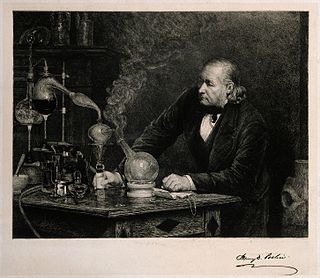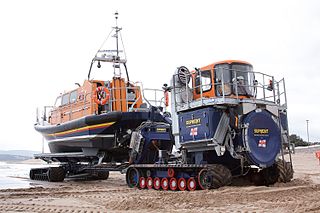
George Wimpey was a British construction firm. Formed in 1880 and based in Hammersmith, it initially operated largely as a road surfacing contractor. The business was acquired by Godfrey Mitchell in 1919, and he developed it into a construction and housebuilding firm. In July 2007, Wimpey merged with Taylor Woodrow to create Taylor Wimpey. Wimpey was first listed on the London Stock Exchange in 1934.

Par is a village and fishing port with a harbour on the south coast of Cornwall, England, United Kingdom. The village is situated in the civil parish of Tywardreath and Par, although West Par and the docks lie in the parish of St Blaise.
The Buell dryer, also known as the "turbo shelf" dryer, is an indirect heated industrial dryer once widely used in the Cornwall and Devon china clay mining industry. The Buell dryer was introduced to the china clay industry by English Clays Lovering Pochin & Co. Ltd for their china clay drying plants in Cornwall and Devon, as part of the mechanization and modernization of the industry, which up to that point had been using the same primitive processing methods for almost 100 years.

Trewoon is a village in south Cornwall, England, United Kingdom. It is on the western outskirts of St Austell, on the A3058 road and is a linear settlement, with housing estates, a village hall, park and playing fields. The village has many amenities and local businesses: a garage, a post office, a Convenience store, hairdressers, "The White Pyramid" pub, and Trinity Methodist church.
Bellway plc is a residential property developer and housebuilder based in Newcastle upon Tyne, England. It is listed on the London Stock Exchange and is a constituent of the FTSE 250 Index.
Vistry Group is a British house-building company based in Kings Hill, England. It is listed on the London Stock Exchange and is a constituent of the FTSE 250 Index.

Crest Nicholson is a British housebuilding company based in Chertsey, Surrey. It is listed on the London Stock Exchange and is a constituent of the FTSE 250 Index.
Westbury plc was an English housebuilding company based in Cheltenham, Gloucestershire. It was listed on the London Stock Exchange and was a constituent of the FTSE 250 Index but was acquired by Persimmon plc in 2005.

Taylor Woodrow was one of the largest housebuilding and general construction companies in Britain. It was listed on the London Stock Exchange and was a constituent of the FTSE 100 Index until its merger with rival George Wimpey to create Taylor Wimpey on 3 July 2007.

Henry Davis Pochin was an English industrial chemist. He invented a process that enabled white soap to be made and a means of using china clay to create better quality paper. He owned several china clay pits in Cornwall, and a mine at Tredegar in South Wales, and was briefly a Liberal Member of Parliament. His wife was Agnes Pochin who was a leading suffragist.

Imerys S.A. is a French multinational company which specialises in the production and processing of industrial minerals. It is headquartered in Paris and is a constituent of the CAC Mid 60 index.
Tarmac Group Limited was a British building materials company headquartered in Wolverhampton, United Kingdom. It produced road surfacing and heavy building materials including aggregates, concrete, cement and lime, as well as operating as a road construction and maintenance subcontractor.

The Cornwall Minerals Railway owned and operated a network of 45 miles (72 km) of standard gauge railway lines in central Cornwall, England, United Kingdom. It started by taking over an obsolescent horse-operated tramway in 1862, and it improved and extended it, connecting Newquay and Par Harbours, and Fowey. Having expended considerable capital, it was hurt by a collapse in mineral extraction due to a slump in prices. Despite its title, it operated a passenger service between Newquay and Fowey.
Broseley Estates Limited, also referred to as Broseley Homes, was a housebuilder based in Leigh, Lancashire which operated from the 1950s until the 1980s.
McLean Homes was a major British housebuilding business.
Beazer was a family business for six generations before expanding in the 1980s into international housebuilding, construction and building materials group. After becoming overburdened with debt it was rescued by Hanson plc in 1991. A new Beazer Group, comprising solely the UK housebuilding business, was demerged from Hanson in 1994, and bought by Persimmon plc in 2001.
William Leech PLC was a major Tyneside housebuilder.

Blackhill Engineering is a British engineering and metalwork fabrication company. The company is based in Devon and has been trading for over 60 years.

Par Docks is an Imerys-owned harbour in the village of Par, Cornwall, United Kingdom, which was used for the export of china clay from the numerous Imerys sites in the clay-rich region of Mid-Cornwall.
The Cornish China Clay Branches are a number of railway branch lines that serve facilities that produce or process China Clay. The area of Cornwall north of St Austell stretching from Bodmin Moor towards Truro is known for the extraction and processing of commercial volumes of China Clay, and with the expansion of the railways in the 19th century a number of lines were constructed to access various mines and clay-dries. Some branches have closed over the years, but several still operated into the 21st century although much of the China Clay traffic has transferred to road transport. In 2020 rail traffic remained in the shape of regular trains running between Parkandillack and the wharves at Carne Point where the large volumes required to be loaded onto ships for export would make road transport uneconomic.










